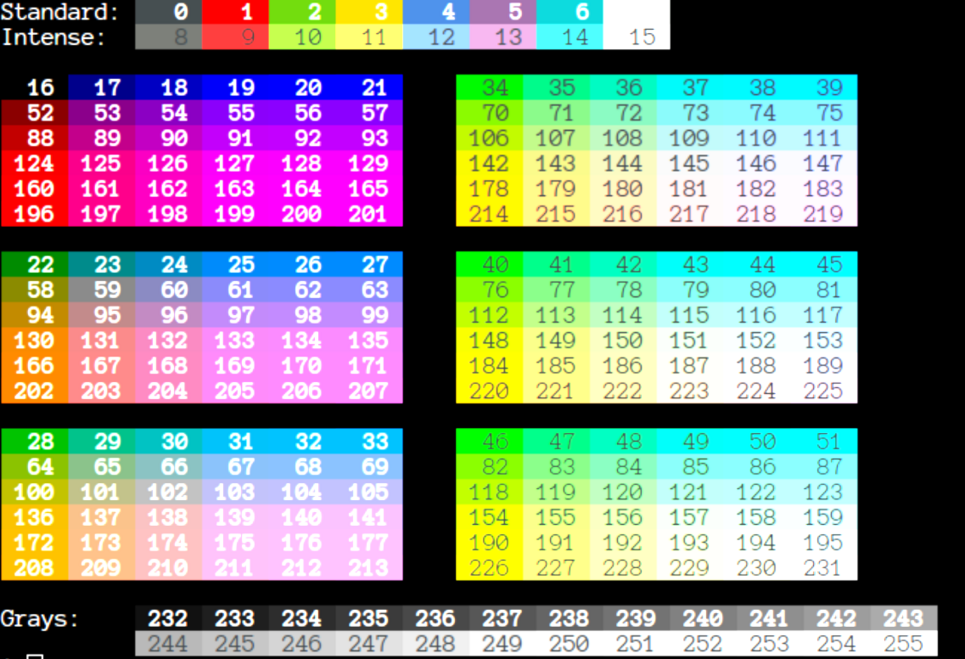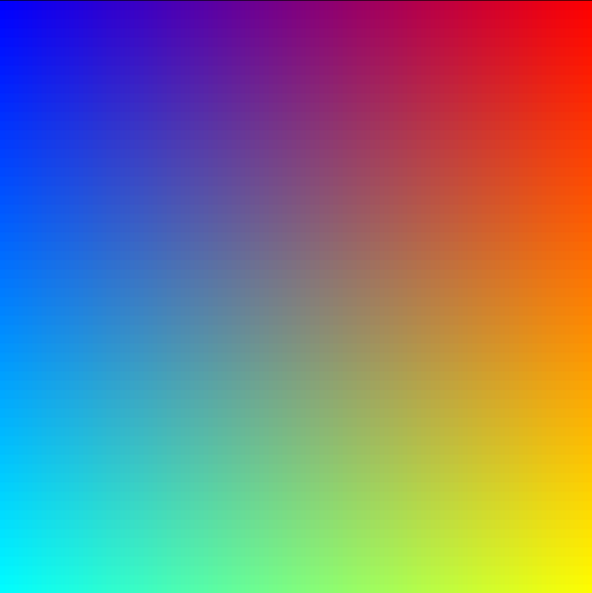ANSI
Les codes d'échappement
| Code | Abbr | Name | Effect |
|---|---|---|---|
| CSI n A | CUU | Cursor Up | Moves the cursor n (default 1) cells in the given direction. If the cursor is already at the edge of the screen, this has no effect.
|
| CSI n B | CUD | Cursor Down | |
| CSI n C | CUF | Cursor Forward | |
| CSI n D | CUB | Cursor Back | |
| CSI n E | CNL | Cursor Next Line | Moves cursor to beginning of the line n (default 1) lines down. (not ANSI.SYS)
|
| CSI n F | CPL | Cursor Previous Line | Moves cursor to beginning of the line n (default 1) lines up. (not ANSI.SYS)
|
| CSI n G | CHA | Cursor Horizontal Absolute | Moves the cursor to column n (default 1). (not ANSI.SYS)
|
| CSI n ; m H | CUP | Cursor Position | Moves the cursor to row n, column m. The values are 1-based, and default to 1 (top left corner) if omitted. A sequence such as CSI ;5H is a synonym for CSI 1;5H as well as CSI 17;H is the same as CSI 17H and CSI 17;1H
|
| CSI n J | ED | Erase in Display | Clears part of the screen. If n is 0 (or missing), clear from cursor to end of screen. If n is 1, clear from cursor to beginning of the screen. If n is 2, clear entire screen (and moves cursor to upper left on DOS ANSI.SYS). If n is 3, clear entire screen and delete all lines saved in the scrollback buffer (this feature was added for xterm and is supported by other terminal applications).
|
| CSI n K | EL | Erase in Line | Erases part of the line. If n is 0 (or missing), clear from cursor to the end of the line. If n is 1, clear from cursor to beginning of the line. If n is 2, clear entire line. Cursor position does not change.
|
| CSI n S | SU | Scroll Up | Scroll whole page up by n (default 1) lines. New lines are added at the bottom. (not ANSI.SYS)
|
| CSI n T | SD | Scroll Down | Scroll whole page down by n (default 1) lines. New lines are added at the top. (not ANSI.SYS)
|
| CSI n ; m f | HVP | Horizontal Vertical Position | Same as CUP, but counts as a format effector function (like CR or LF) rather than an editor function (like CUD or CNL). This can lead to different handling in certain terminal modes. |
| CSI n m | SGR | Select Graphic Rendition | Sets colors and style of the characters following this code |
| CSI 5i | AUX Port On | Enable aux serial port usually for local serial printer | |
| CSI 4i | AUX Port Off | Disable aux serial port usually for local serial printer | |
| CSI 6n | DSR | Device Status Report | Reports the cursor position (CPR) by transmitting ESC[n;mR, where n is the row and m is the column.
|
| CSI s | SAV | Save cursor | Save the current cursor position (L;C). to be used with RCL |
| CSI u | RCL | Restore cursor | Move back cursor to the position saved by SAV |
Les styles
Il s'agit de détailler les codes :
| CSI n m | SGR | Select Graphic Rendition | Sets colors and style of the characters following this code |
Le tableau suivant donne les modes existants:
* Les exemples sont pris sut putty/mobaxterm. N/A c'est que, sur les terminaux caractère standards ce code est sans effet.
Les couleurs
Couleurs de bases
On à 8 couleurs de bases + les mêmes couleurs en surintensité. (à la CGApour ceux qui s'en souviennent)
| 30–37 | Set foreground color | |
| 90-97 | Set bright foreground color | |
| 40–47 | Set background color | |
| 100-107 | Set bright background color |
On peut chainer les changements en une seule commande:
printf "\n\e[31;47m Hello Wor\e[0m\n\n"
Passe en rouge sur fond blanc!
Couleurs étendues
Là on passe aux écrans EGA, On agrandie la palette:
Le nombre indique la couleur de fond :
ESC[48:5:⟨n⟩m Select background color
La couleur du texte est soit blanc soit noir pour qu'on puise le voir. Pour changer la couleur du texte on peut, de la même façon,
ESC[38:5:⟨n⟩m Select foreground color
Attention avec putty, cygwin et donc mobaxterm, par défaut, ces subtilités ne sont pas gérées. En revanche le terminal de base linux sur raspberry PI et MINGW64 sous Windows marche tres bien.
#!/usr/bin/perl
my $c=0;
for ($i=16; $i<=231; $i++) {
printf "\033[48:5:%3sm ", $i;
$c++;
if (($c % 36)==0){
print ("\n");
}
}
Nous donne:
En 24 bits
On passe au VGA. 8 bits par composantes r, g et b. 8x3=24 bits. Ca fait quelque chose comme 17 million de couleurs différentes (16 777 216 exactement).
#!/usr/bin/perl
#
for ($y=0; $y<=255; $y+=4){
for ($x=0; $x<=255; $x+=2){
printf ("\033[48;2;%s;%s;%sm ",$x,$y,255-$x);
}
print ("\033[0m\n");
}
Nous donne un joli:
Comme quoi dans un terminal en mode caractère on peut faire de joli dessins!
Ces couleurs en 24 bits sont, elles, correctement gérées par putty/mobaxterm.
Utiliser dans du code
L'utilisation des codes ANSI dans un programme peut se faire en incluant simplement les codes d’échappement dans les chaines de caractères écrites à l'écran.
Ainsi pour écrire!
On utilisera la chaine :
"Hello \033[7m world \033[0m !"
En shell
Attention en bash ou tout descendant du bourne shell un simple:
echo "Hello \033[7m world \033[0m !"
Donnera ...
Hello \033[7m world \033[0m !
Il faut préciser l'option -e (enable escape characters)
echo -e "Hello \033[7m world \033[0m !"
Ou (seulement en bash) la commande printf dont la syntaxes est celle du C.
printf "Hello \033[7m world \033[0m !\n"
En C/C++
void main(int argc, char** argv){
printf ("Hello \033[7m world \033[0m !\n");
}
En perl
On peut faire simplement :
print "Hello \033[7m world \033[0m !\n";
Mais on peut utiliser la module Term::ANSIColor
Il y a pas mal de façon de l'utiliser. La plus simple :
use Term::ANSIColor qw(:constants);
print "[".GREEN."PASS".RESET."]\n";
print "[".RED."FAIL".RESET."]\n";
Les constantes utilisables:
CLEAR RESET BOLD DARK
FAINT ITALIC UNDERLINE UNDERSCORE
BLINK REVERSE CONCEALED
BLACK RED GREEN YELLOW
BLUE MAGENTA CYAN WHITE
BRIGHT_BLACK BRIGHT_RED BRIGHT_GREEN BRIGHT_YELLOW
BRIGHT_BLUE BRIGHT_MAGENTA BRIGHT_CYAN BRIGHT_WHITE
ON_BLACK ON_RED ON_GREEN ON_YELLOW
ON_BLUE ON_MAGENTA ON_CYAN ON_WHITE
ON_BRIGHT_BLACK ON_BRIGHT_RED ON_BRIGHT_GREEN ON_BRIGHT_YELLOW
ON_BRIGHT_BLUE ON_BRIGHT_MAGENTA ON_BRIGHT_CYAN ON_BRIGHT_WHITE
On se limite aux couleurs mais le module permet beaucoup de choses. Une description en français est disponible sur la page du module lui même.
En java
class HelloWorld {
public static void main(String[] args) {
System.out.println("Hello \033[7m world \033[0m !");
}
}
Bon au retour à la ligne près (certaint l'incluent par défaut d'autres pas) c'est toujours la même chaine.
Un langage fait le malin pour pas faire comme les autres python
En python
Un simple
print ("Hello \033[7m world \033[0m !")
Affiche:
Il interprète (un peu) les codes ANSI pour les remplacer par... des espaces. Etrange.
Pour utiliser les codes ANSI il faut utiliser une autre syntaxe et, de plus, seul les changements de couleurs (3x pour la couleur du texte et 4x pour le fond) sont acceptés.
print (u"Hello \u001B[47m\u001B[30m World \u001B[0m !")
Nous donne "presque" ce que nous attendons.
Le "World" est écrit en noir sur fond blanc sale. en Gris quoi.
N'essayez pas de remplacer \001B[47m par \001B[107m ça ne marches pas.
Python a "sa syntaxe":
print (u"\nHello \u001B[47;1m\u001B[30m World \u001B[0m !")
Le ;1 après le \u001B[47 et le m dit que la couleur doit être "vive".
Un nombre limité de fonctions de gestion de curseur sont aussi gérées:
- Up:
\u001b[{n}Amoves cursor up byn - Down:
\u001b[{n}Bmoves cursor down byn - Right:
\u001b[{n}Cmoves cursor right byn - Left:
\u001b[{n}Dmoves cursor left byn
- Next Line:
\u001b[{n}Emoves cursor to beginning of linenlines down - Prev Line:
\u001b[{n}Fmoves cursor to beginning of linenlines down
- Set Column:
\u001b[{n}Gmoves cursor to columnn - Set Position:
\u001b[{n};{m}Hmoves cursor to rowncolumnm
- Clear Screen:
\u001b[{n}Jclears the screenn=0clears from cursor until end of screen,n=1clears from cursor to beginning of screenn=2clears entire screen
- Clear Line:
\u001b[{n}Kclears the current linen=0clears from cursor to end of linen=1clears from cursor to start of linen=2clears entire line
- Save Position:
\u001b[{s}saves the current cursor position - Save Position:
\u001b[{u}restores the cursor to the last saved position
Ces infos ont été trouvées sur : https://www.lihaoyi.com/post/BuildyourownCommandLinewithANSIescapecodes.html
En Python ce qui est compliqué devient très simple (numpy par exemple permet de gérer des matrices de réels en deux lignes de code) mais ce qui était simple (écrite en inversion vidéo) devient très compliqué!

